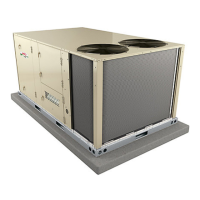Page 32
G-Refrigerant Charge and Check - Fin/Tube Coil & TXV
LGH/LCH094U, 122U, 152U
WARNING-Do not exceed nameplate charge under
any condition.
This unit is factory charged and should require no further
adjustment. If the system requires additional refrigerant,
reclaim the charge, evacuate the system, and add
required nameplate charge. This unit is equipped with
solenoid valves which do not allow refrigerant flow between
the high side and the low side when the unit is de-energized.
When reclaiming/evacuating the system, make sure
refrigerant/vacuum is pulled from both the suction and
discharge lines. When adding nameplate charge, add 1/3 to
the suction line and 2/3 to the discharge line.
NOTE - System charging is not recommended below
60°F (15°C). In temperatures below 60°F (15°C) , the
charge must be weighed into the system.
If weighing facilities are not available, or to check the
charge, use the following procedure:
IMPORTANT - Charge unit in standard cooling mode.
1- Attach gauge manifolds and operate unit in cooling
mode with economizer disabled until system
stabilizes (approximately five minutes). Make sure
outdoor air dampers are closed.
2- Make sure both compressors are operating.
3- Use a thermometer to accurately measure the
outdoor ambient temperature.
4- Apply the outdoor temperature to tables 19 through
21 to determine normal operating pressures.
Pressures are listed for sea level applications at
80
5F dry bulb and 675F wet bulb return air.
5- Compare the normal operating pressures to the
pressures obtained from the gauges. Minor
variations in these pressures may be expected due to
differences in installations. Significant differences
could mean that the system is not properly charged
or that a problem exists with some component in the
system. Correct any system problems before
proceeding.
6- If discharge pressure is high, remove refrigerant from
the system. If discharge pressure is low, add
refrigerant to the system.
Add or remove charge in increments.
Allow the system to stabilize each time
refrigerant is added or removed.
7- Use the following approach method along with the
normal operating pressures to confirm readings.
TABLE 19
LGH/LCH094U
Outdoor Coil
Entering Air
Temp
Discharge +10
psig
Suction +5 psig
655 F 238 136
755 F 273 141
855 F 313 143
955 F 361 146
1055 F 396 149
1155 F 448 152
TABLE 20
LGH/LCH122U
Outdoor Coil
Entering Air
Temp
Discharge +10
psig
Suction +5 psig
655 F 250 134
755 F 288 138
855 F 331 141
955 F 378 143
1055 F 412 144
1155 F 463 147
TABLE 21
LGH/LCH152U
Outdoor Coil
Entering Air
Temp
Discharge +10
psig
Suction +5 psig
655 F 266 129
755 F 305 132
855 F 346 134
955 F 391 138
1055 F 443 141
1155 F 498 143
Charge Verification - Approach Method - AHRI Testing
(Fin/Tube Coil Continued)
1- Using the same thermometer, compare liquid
temperature to outdoor ambient temperature.
Approach Temperature = Liquid temperature (at
condenser outlet) minus ambient temperature.
2- Approach temperature should match values in table
17. An approach temperature greater than value
shown indicates an undercharge. An approach
temperature less than value shown indicates an
overcharge.
3- The approach method is not valid for grossly over or
undercharged systems. Use tables19 through21 as
a guide for typical operating pressures.
TABLE 22
APPROACH TEMPERATURE - 094, 122, 152
Unit
Liquid Temp. Minus Ambient Temp.
Full Load (Both Compressors)
094 5°F + 1 (2.8°C + 0.5)
122, 152 4°F + 1 (2.2°C + 0.5)

